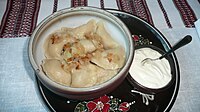Soviet cuisine
This article needs additional citations for verification. (December 2009) |


Soviet cuisine, the common cuisine of the Soviet Union, was formed by the integration of the various national cuisines of the Soviet Union, in the course of the formation of the Soviet people. It is characterized by a limited number of ingredients and simplified cooking. This type of cuisine was prevalent in canteens everywhere in the Soviet Union. It became an integral part of household cuisine and was used in parallel with national dishes, particularly in large cities. Generally, Soviet cuisine was shaped by Soviet eating habits and a very limited availability of ingredients in most parts of the USSR. Most dishes were simplifications of French, Russian, and Austro-Hungarian cuisines. Caucasian cuisines, particularly Georgian cuisine, contributed as well. Canteens run by the government were called stolovaya.[1]
In the West, Soviet cuisine is frequently conflated with Russian cuisine, though the particular national cuisine of Russia is quite different.
Approach

An everyday Soviet full course meal (lunch or dinner) consisted of three or four courses, typically referred to as "the first", "the second", "the third", and "the fourth"; an optional salad was not "numbered". In a restaurant, one could eat anything one liked in any order, but in a typical canteen, especially in a workers' or students' canteen, one would normally have received what was called a "combined lunch" ("kompleksny obed"). "The first" was a soup or broth, i.e., "liquid" food. "The second" was some kind of "solid" food: meat, fish, or poultry with a side dish, called "garnish" (Template:Lang-ru). Garnishes typically included potatoes in a variety of forms, buckwheat kasha, macaroni, etc. Bliny, baked dishes (Template:Lang-ru zapekanka), or eggs could also be served as "the second". "The third" was something to drink: tea, coffee, kompot, milk, kefir, etc. "The fourth" was a dessert.

Green vegetables and salads were seasonal, and with some exceptions uncommon at the table. Spices were rarely used and food had a generally mild taste. There were no differences between breakfast, lunch, and dinner meals. Lunch was always consumed with a soup as a first course. A lot of households used to eat fish instead of meat on Thursdays. The common approach, which still holds today in Russia is: "Eat a lot, few times a day. Eat nothing between meals".[This quote needs a citation] A typical lunch meal could consist of chicken broth based soup or borscht for a first course and fried meatballs or goulash served with boiled potatoes or buckwheat porridge as a main course. Butter or sour cream was used instead of sauce.

Holiday meals were typically derived from old French and Russian cuisines with extensive use of heavy sauces, marinated meats, and melted cheese. Mixing ingredients and extensive cooking was common, just as at classic French cuisine. Generally, people put a lot of effort in order to prepare such meals. Often, the richness of a holiday table was an issue of honor for the family.
Typical dishes






- Olivier (also known as Russian salad)
- Herring under a fur coat
- Kholodets
- Vinegret (from French vinaigrette) - red beet root salad with onions, pickles, boiled potatoes, carrots, dressed with sunflower oil.
- Vitaminniy salat (Vitamin salad) - a cabbage-based salad with seasonal vegetables like tomatoes, cucumbers, onions, carrots, etc.
- Various pickles, such as cucumbers, tomatoes, ramsons, and mushrooms.
- Sauerkraut mixed with carrots and served as a salad.
- Koreyscha Sabzili Salat (Koryo-saram) - a spicy carrot salad.
First course
- Borscht - (Ukrainian)[2]
- Chicken noodle soup
- Kharcho
- Okroshka
- Pacha - (Armenian/Azerbaijani/Georgian)
- Pea soup
- Rassolnik
- Shchi - (Russian)
- Solyanka
- Sorrel soup
- Ukha
Second course
- Beef Stroganoff
- Chicken Kiev (Russian) - a filled chicken cutlet
- Cutlet or meat ball
- Various kinds of dumplings, like pelmeni (Russian),[3] vareniki (Ukrainian), or manti (Central Asian),
- Goulash, ragout, or another kind of stew
- Golubtsy - cabbage rolls stuffed with rice and meat and served in tomato sauce
- Plov (Uzbek) - rice dish
- Sausages
- Shashlik - (Caucasus)
Third course
Usually served in a 200 millilitres (7.0 imp fl oz; 6.8 US fl oz) glass in common diners of obshchepit.
- Cocoa
- Coffee with milk (black coffee was an extra)
- Kefir (Turkic)
- Kissel (drinkable starch-based fruit jelly)
- Kompot (Slavic)
- Kvass
- Milk
- Ryazhenka (Ukrainian)
- Tea
Desserts
Breakfasts
Street food
See also
- Russian cuisine
- Ukrainian cuisine
- Belarusian cuisine
- Uzbek cuisine
- Kazakh cuisine
- Georgian cuisine
- Azerbaijani cuisine
- Lithuanian cuisine
- Moldovan cuisine
- Latvian cuisine
- Kyrgyz cuisine
- Tajik cuisine
- Armenian cuisine
- Turkmen cuisine
- Estonian cuisine
References
- ^ Long, Katherine. "Everyone Loves Lenin". Roads & Kingdoms.
- ^ "Missing Soviet cuisine since 1991." The Cascade. Accessed July 2011.
- ^ "Russian Traditional Foods." Goeasteurope.about.com. Accessed July 2011.
